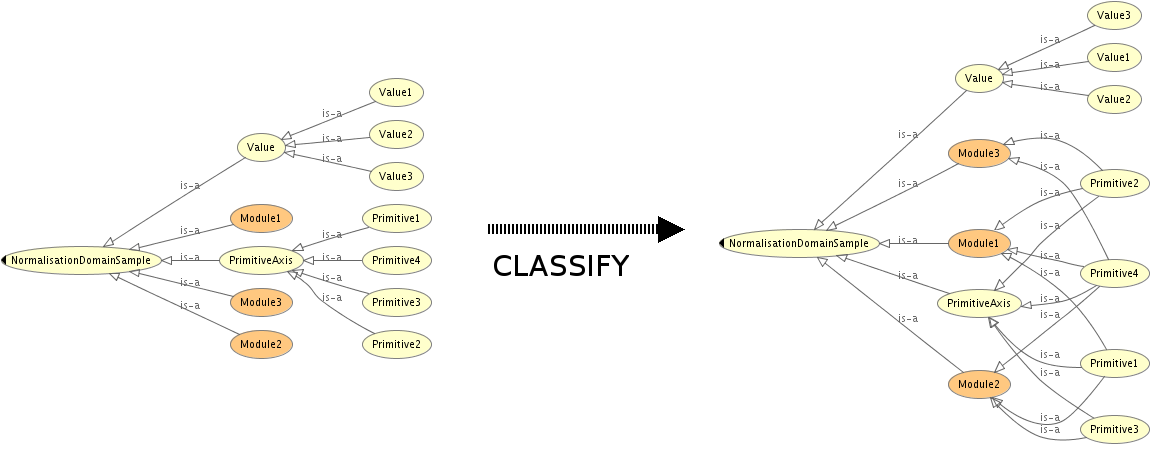Graphical representation
Diagram
General information
| Name | Normalization |
| Also known as | Modularization, Untangling |
| Author(s) | AlanRector, MikelEganaAranguren |
| SubmittedBy | BenedictoRodriguezCastro |
Description
| Motivation | There are ontologies where a given class can have plenty of superclasses, building a polyhierarchy. If all those subsumption relationships are directly stated by the ontology maintainer, two main problems rise: (i) the ontology becomes very difficult to maintain: whenever a subsumption must be deleted (because a class has changed) or created (because a new class has been created) it has to be done by hand; in a polyhierarchy the process becomes very inefficient and error-prone. (ii) the semantics are implicitly stated, not explicitly: any other ontologist or reasoner only knows that a class is a subclass of its superclasses, without knowing why. |
| Aim | To untangle a polyhierarchy, coding the subsumption relationships using restrictions rather than class-subclass relationships. The application example for this ODP is adapted from the Cell Type Ontology. In the example, the subsumption relationships that already are in the Cell Type Ontology are inferred by the reasoner instead of hard-coded. The term Neutrophil is used as an example class to show how a class can relate to different modules. |
| Solution description | |
| Elements | The original classes of the ontology are divided in different axes. The conditions for each subsumption relationship are encoded as restrictions (e.g. [PerformsFunction some Defense]) that will relate the different modules. |
| Implementation | Identify the modules: group the classes. Create the modules, maintaining only one parent for any given primitive class and making primitive siblings disjoint. Redefine the classes (or define the newly added classes) according to the conditions for belonging to each module. Protege includes a wizard, the restrictions matrix, that helps in the process. |
| Reusable component | |
| Component type |
Example
| Problem example | |
| Pattern solution example | http://ontologydesignpatterns.org/wiki/Image:Normalisation_instance.png |
| Consequences | The ontology gets untangled and becomes a collection of neat modules. The rest of the semantics are given by restrictions pointing to the modules, and the reasoner maintains the structure, avoding error-prone human maintenance of the polyhierarchy. |
Pattern reference
| Origin | See (Rector, 2003) |
| Known use | See (Rector, 2003) |
| Reference | |
| Related ODP | |
| Used in combination with | |
| Test |
Additional information
Scenarios
Scenarios about Normalization No scenario is added to this Content OP.
Reviews
Reviews about Normalization
| Review article | Posted on | About revision (current is 10129) |
|---|---|---|
| CatherineRoussey about Normalization | 245545010 September 2010 | 1007110,071 |
| BorisVillazón-Terrazas about Normalization | 245545616 September 2010 | 1007110,071 |
| MariCarmenSuarezFigueroa about Normalization | 245545717 September 2010 | 1011510,115 |
| AndreaNuzzolese about Normalization | 245545919 September 2010 | 1011510,115 |
This revision (revision ID 10129) takes in account the reviews: none
Other info at evaluation tab
Modeling issues
Modeling issues about Normalization
| Modeling issue | Competency question | Domains |
|---|---|---|
| Multiple Alternative Classification Criteria | Allow me to retrieve all "elements" (classes/individuals) of a "domain concept" viewed by a combination of "values" (or "terms") from various "classification criteria" (or "facets"). | |
| View Inheritance | For examplein the case of the representation of the "wine" domain concept: region flavour and(or) ocassion. the toppings and(or) the name. |
References
- Alan L. Rector. Modularisation of domain ontologies implemented in description logics and related formalisms including owl. In K-CAP '03: Proceedings of the 2nd international conference on Knowledge capture, pages 121{128, New York, NY, USA, 2003. ACM. ISBN 1-58113-583-1. Documentation | reference page* Normalization Ontology Design Pattern Documentation | reference page* Egana-Aranguren, Mikel. Role and Application of Ontology Design Patterns in Bio-ontologies. PhD thesis, School of Computer Science, University of Manchester, 2009. Documentation | reference page
